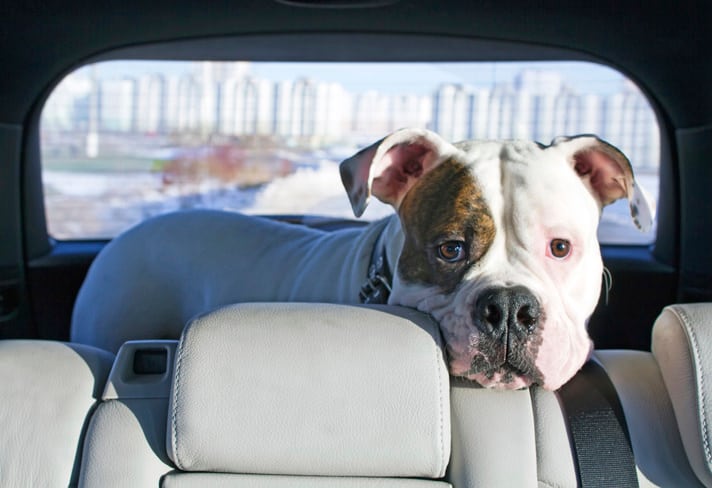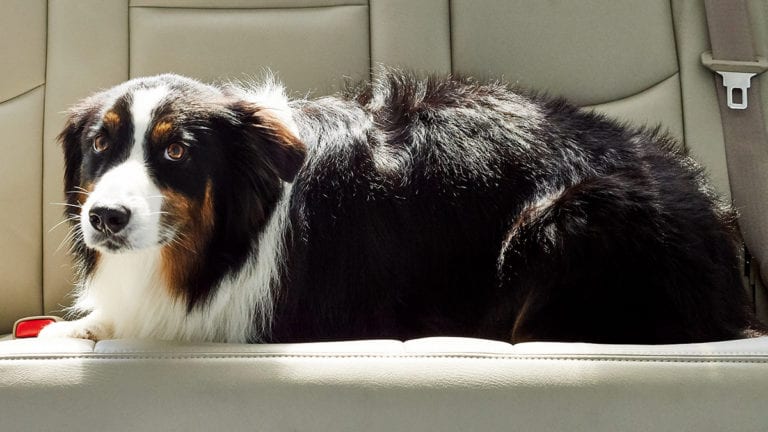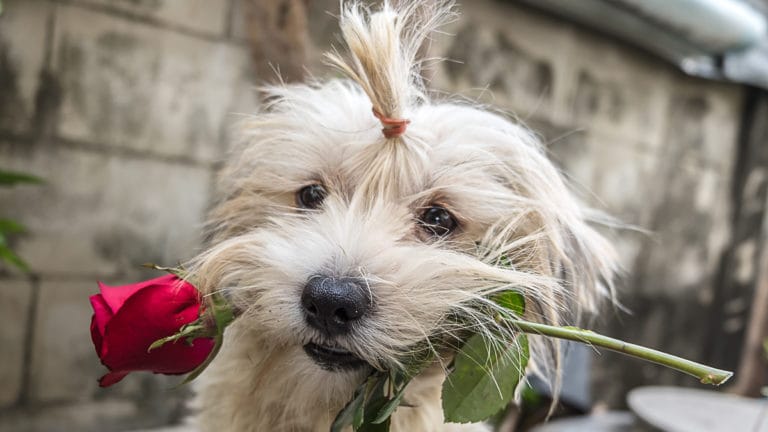Your new dog won’t even walk toward the garage. Your year-old Doberman needs to be picked up and placed in the car, but then he shakes the entire time you drive, no matter how near or how far. Your new puppy drools and vomits and looks like the world’s saddest pup every time you put him in the car. Your 10-year-old Golden Retriever heads for the hills when you pick up your car keys.
Sound familiar? Many dog owners have experienced a similar scenario occur. Is there hope for having a happy drive with your dog? Of course!
Identifying Your Dog’s Car Fear
The first thing you need to do is realize that your dog’s fear of car rides is real. It all starts with associations. For whatever reason, your dog has made bad associations with vehicles, and your job is to help him make new, good ones. The most common causes of a dog’s fear of riding in cars include:
- The only time your dog has been in a vehicle was to leave his mom and siblings and/or go to the vet.
- Your dog traveled on a long transport during a critical developmental stage.
- Your dog was scared while riding in a vehicle.
- Your dog gets carsick.
- Your dog is a sensitive soul and needs a bit of time and understanding.
You may or may not know where this fear originated from, but the good news is that the treatment is pretty much the same. How long it takes to overcome the fear will vary from dog to dog, and it depends on the depth of the dog’s fear or phobia.
Two Methods To Overcoming Fear Of Riding In Cars
For some dogs, the kindest thing to do is discuss the issue with your veterinarian and have him or her prescribe something to help calm your dog’s nerves. Any prescription should be discussed between you and your vet. Please do not try to medicate your dog on your own or take medical advice from well-meaning friends.
I work with a lot of dogs who fear car rides. One of the first things I do is to teach them to put their paws up and then to jump up onto something. By teaching “paws up,” you are creating a new task and strengthening your bond before you tackle the car.
I like to teach “paws up” by shaping it. Shaping helps to give the dog some control. It is much easier to move forward when the other party is on board.
Steps For Shaping “Paws Up”
Start by encouraging the dog to put his paws on something low and stable. I often use a 10-gallon, rubber, horse feed bucket. This also helps dogs who are unsure of surfaces and things that move when their feet touch it. This training should be fun for you and your dog.
Keep in mind that you are rewarding the position. Your dog will get a jackpot reward for putting his paws up on something. You then toss the treat away from the item and encourage your dog to “go get” the food. Position yourself between the dog and the perch (think of a clock — you are at 12 and the dog is at 6) and encourage the dog to come to you. Play this game on many surfaces.
So, your dog is now a “paws up” expert. Next step is playing around with jumping all four feet on different surfaces. Use the same training method, but this time you want your dog to jump up and put all four paws on a surface. This should be awesome fun!
Once your dog eagerly jumps with all four feet onto different types of safe surfaces, your next step is to counter-condition the vehicle so that fun happens there.
Make The Car A Fun Place
Stand near the vehicle with high-value treats. If the dog looks in your general direction, throw food away. You must throw the food beyond your dog so he must go away from the car. What you are trying to accomplish here is rewarding your dog for coming toward the car on his own, as he should come toward you after retrieving the treat.
Move at the speed of your dog’s comfort level. For some dogs the sight of the vehicle causes terror; for others the fear won’t hit until you start driving. There will, of course, be many dogs at various stages in between.
Your dog should be actively interacting with you before you move to the next stage, which is opening the car door, but standing farther away from the car. Think of this from your dog’s point of view. It is not a reward to get closer to the car.
Now you are ready to play the game with you sitting in the car. If you are pulling the dog leash toward the car, you moved too fast and you’ll need to go back a few steps. If your dog is relaxed and readily walks to the vehicle, it is time to play “paws up” on the car. Reward your dog for two paws up and play the “go get it” game.
Another fun game for the bigger dogs is to open up the doors and play “let’s chase the food through the car” — where he goes in one door and out the other. Sometimes it helps to have another dog who loves the car go first.
Now go back and repeat the whole thing with the car engine running.
Now that you have come (or gotten) this far, the next step is to feed the dog something super special, first with the engine off. and then running.
Don’t rush this step. Remember, we are creating new, warm-fuzzy associations with the car. When you do finally go on a drive, be sure to go a very short distance. Your destination should either be just around the block or somewhere very close and fun. Build up to longer drives from there.
Shop Related Products on Chewy
Offering Reassurance And Understanding Carsickness
It has been my experience that a lot of dogs get really insecure in the car when they are more than a few inches away from those they love. If your dog is riding in a crate, a car seat or harness, be sure to get him used to restraints beforehand. For the time being, you may want someone to ride near the dog. You driving in the front seat with your dog in the back of an SUV can be terrifying for some dogs; many of my clients report that their dogs are fine if they are close to someone. I had the same experience with my Collie Finney. He got over his carsickness very quickly by riding in between my kids.
A few words on carsickness. Many dogs become afraid of the car because they get carsick. I have had several carsick foster dogs over the years, including the one in my profile photo. I followed all the advice that I give to scores of people every year:
- I didn’t take the dogs on a full stomach.
- I drove short distances to someplace fun.
- I had someone ride with them.
- I played soothing music.
- I gave them ginger.
The result? It was still Puke City.
The one thing that has helped every carsick dog I ever cared for? As soon as they started to look a little green behind the gills, and especially at the first sign of drool, I pulled over, took them out of the car, let them get their sea legs and then carried on. Be prepared to make a lot of stops.
Happy training, and happy traveling!
By: Nancy Freedman-Smith
Share:









